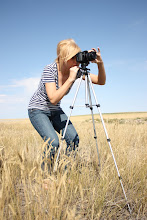Narrow Depth of Field
To create a narrow depth of field in a photograph, you need to set your camera to a low f stop, and depending on the amount of light, you need to adjust your shutter speed to complement the low f stop. In low light situations, you may need to bump up your ISO so your photograph doesn't come out too dark.
With a low f stop, you are only going to have a small portion of your photograph in focus and the rest will be blurred. The amount of blur in the photograph will depend on your lens and how low the f stop is. (f/1.8=very blurry or not much is in focus, f/22=not blurry or everything's in focus)
On my rebel xsi, the aperture button is on the face of the camera. You have to hold that button down and use the shutter speed dial to adjust the f stop. The ISO button is near the shutter speed dial; both are located on the top right of the camera.
Wide Depth of Field
To achieve a wide depth of field, you need to do the opposite of what you would with a narrow depth of field. Your goal is to get most, if not all, of the photograph in focus, therefore you need to have a higher f stop. From there, you need to adjust the shutter speed and ISO to fit the right exposure with this particular f stop.
(Note: The above mentioned steps are if you have your camera set to manual. There are aperture and shutter priority settings that makes this process easier. In that case, you set your aperture or shutter and the camera does the rest for you to achieve the right exposure.)
Short Exposure
With long and short exposures, your focus is shutter speed. The dial for shutter speed adjustment, as mentioned earlier, is found on the top right hand of the rebel xsi. For a short exposure, your shutter speed needs to be relatively fast. Depending on what you are shooting and the speed in which the object you are shooting is moving... the shutter speed needs to be adjusted. (Faster the object=Faster shutter speed.)
Long Exposure
To get a long exposed picture, once again, use the shutter speed dial and instead of raising the shutter speed for a short exposure, the shutter speed needs to be slow for the long exposure. Long exposures are for inanimate objects, or for blurring of motion. In those situations, the more blur you want, the lower shutter speed you want.
Subscribe to:
Post Comments (Atom)

No comments:
Post a Comment